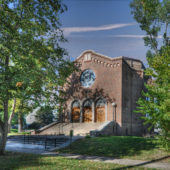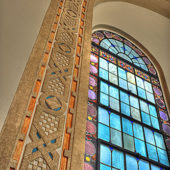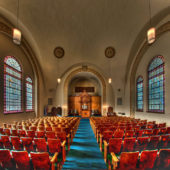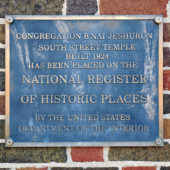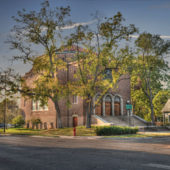Originally founded in 1884 and the only synagogue between Omaha and Denver, because of its relatively small size the congregation has often been served by newly trained rabbis.
Arriving in Lincoln, Nebraska in 1868 Moses Oppenheimer family were the first Jews to settle in the town. Moses’ brother, Isaac and his family joined them a year later. Both Moses and Isaac were engaged in the millinery (hat making) business. During the 1870s and 1880s more Jews arrived in Lincoln, including a jeweler, a men’s clothier, a general merchandiser, a cigar manufacturer, a men’s clothing store operator, and livery stable owner. Most of them were of German origin, although some were from Poland and Russia.
Lincoln’s first Jewish congregation, B’nai Jeshurun (Children of Israel) was founded in 1884. One of B’nai Jeshurun’s early members was a founder of the Anti-Defamation League of B’nai B’rith (the oldest and largest Jewish service organization in the world). These early members of B’nai Jeshurun were engaged in agriculture, clothing, wholesale and retail food products, banking and auto parts, as well as other retail and service businesses. In 1893, when there were 28 members, the congregation’s first temple was completed. A Rabbi was hired in 1906. Following the destruction of the building in 1922 a massive fundraising effort was undertaken in 1922-23, and the Lincoln architectural firm of Davis and Wilson was commissioned to design a new building. On April 26, 1923, ground was broken for the new temple. In 1924 the new temple, known as The South Street Temple, was completed. It has been placed on the National Register of Historic places.
The synagogue’s stately exterior is of red brick with stone colored molding, featuring a Moorish flair. Its architectural styling is reminiscent of other Reform synagogues of the period, notably Congregation Rodef Shalom in Philadelphia, although smaller. It boasts three sets of double, carved wood front entrance doors, set under molded archways with half-circular windows above. A wide flight of stairs leads up to this grand entranceway. A stunning, large, Star-of-David rose window is featured above the doors. Just below the roof peak are twin tablets in stone, featuring The Ten Commandments. Inside the elegant prayer room, a vaulted ceiling, and ivory walls feature sweeping archways encompassing each wall, with the archways lined in a magnificent Byzantine motif of browns, golds, and reds. Along the side walls there are three arched stained glass windows on each side. A Star-of-David rose window is at the back of the sanctuary. The bimah at the front of the prayer room is set back in an alcove under an archway. The Aron Kodesh is an imposing piece of furniture, hand carved from walnut by one of the congregant’s father. Walnut walls flank a classical edifice with Corinthian columns supporting an intricately carved entablature featuring detailed Byzantine motifs. A Star-of-David is predominantly featured in the center of the entablature. Torah scrolls are splendidly displayed in covers of white velvet embroidered with silver, with silvery finials. In front of the Aron Kodesh stands the tivah (reader’s desk), also hand carved in walnut by a congregant’s father. Beautiful detailing is incorporated into the design. Purpose built, simple wooden chairs fill the sanctuary, sitting on blue linoleum. Vivid blue carpeting adorns the center aisle and bimah.
The congregation’s practices are consistent with the mainstream Reform movement. Congregation B’nai Jeshurun, also known as South Street Temple, is characterized by accepting diversity within their congregational family, embracing intermarried families and Jews by choice, as well as outreach to the community. There is a strong emphasis on religious education for the children. The congregation has excellent relations with the Conservative congregation in the city, is developing a junior high program, engages in social action and takes pride in the community.

